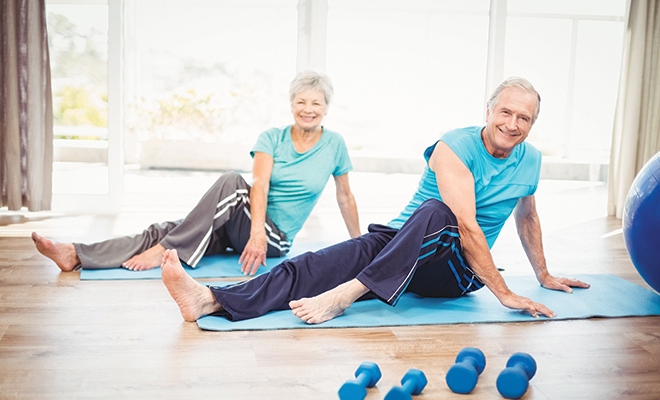
Active Senior Living: Keep Moving!
There are many reasons folks tend to slow down as they age. They may struggle with health problems, weight or pain issues or just worry about falling.
They might even think that because they are older, there’s no need for exercise or fitness. However, as people advance in years, an active lifestyle is highly important to overall health, wellness and vitality. Now’s the time for you to get up, get out and get going. Not only will the activity boost your energy and maintain your sense of independence, it will also protect your heart and manage the symptoms of illness or pain. Plus, it’s a great way to keep weight in check, not to mention the positive impact it has on your mood and memory.
Unfortunately, many adults age 65 and over spend, on average, ten hours or more sitting or lying down every day. This sedentary lifestyle comes at a price in terms of overall health and wellness, as this demographic suffers higher rates of falls, obesity, heart disease and early death compared to the general population. Therefore, as you age, it’s necessary to remain active if you want to stay healthy and maintain independence. Failing to do so may eventually take away the things you once took for granted, such as shopping on your own or playing with your grandchildren. You may begin to realize a host of new aches and pains that never bothered you before, and the likelihood of sustaining a fall increases.
Strong evidence suggests that those who embrace an active lifestyle have a lower risk of heart disease, type 2 diabetes, stroke, certain cancers, depression and even dementia. In order to potentially ward off these illnesses and keep mental illness and aches and pains at bay, the best advice is to keep moving. It doesn’t have to be complicated, either. You don’t have to run a marathon or commit to hours at the gym every day. Physical activity can mean something as easy as a daily walk or doing some gardening. The goal is at least 150 minutes of moderate activity each week. In addition to walking and gardening, consider taking a water aerobics class, riding a bike on ground level, playing doubles tennis or even pushing a lawn mower. Even your daily chores, such as shopping, cooking or housework, qualify as physical activity as they keep you from sitting in front of the television or computer screen all day.
Also of key importance for seniors is to integrate some weight training into the daily physical activity routine, and that can mean doing some heavy gardening or carrying a few heavy loads. Certainly, what you are capable of doing depends on your own circumstances, and it’s advisable to speak with your physician prior to engaging in any type of physical exercise. The main rule of thumb, however, is do pick something you enjoy doing and aim to do that for at least 30 minutes a day.
If you’re quick to say, “I hate to exercise,” you’re not alone. The beauty of fitness is that you can choose what interests you the most. Listen to music or an audio book while lifting weights. Grab a friend and do some window shopping while walking laps at the mall. Go on a nature hike with your camera and snap some photos. Sign up for a yoga class at your local fitness center, or watch your favorite TV show while walking on the treadmill. If you like to get out on the golf course, walk the course instead of using the cart.
Take your dog to the dog park for a game of fetch. If you don’t own a dog, volunteer to take your neighbor’s dog for a walk or volunteer at a local pet shelter. If you routinely meet a friend for a cup of coffee, invite that friend to join you in conversation while walking, stretching or strength training. If you find it difficult to get in the exercise saddle, grab an exercise buddy and find something you love to do together. Also, check out what your local recreation center has to offer, as those facilities typically offer senior sports or fitness classes, all designed to keep you motivated while simultaneously providing a source of fun, stress relief and a place to meet friends.
While it’s not possible to turn back the clock, you don’t have to settle for a sedentary life past middle age. Sure, things will happen as we age, and that’s completely normal, but it doesn’t have to translate to being frail. Understand, too, creating an active lifestyle extends beyond just health and fitness. It can also allow you to continue pursuing the hobbies and interests you enjoy, whether wood carving, playing the piano, dancing or singing in the church choir. ■
Sources: nhs.uk, healthline.com, helpguide.org.







